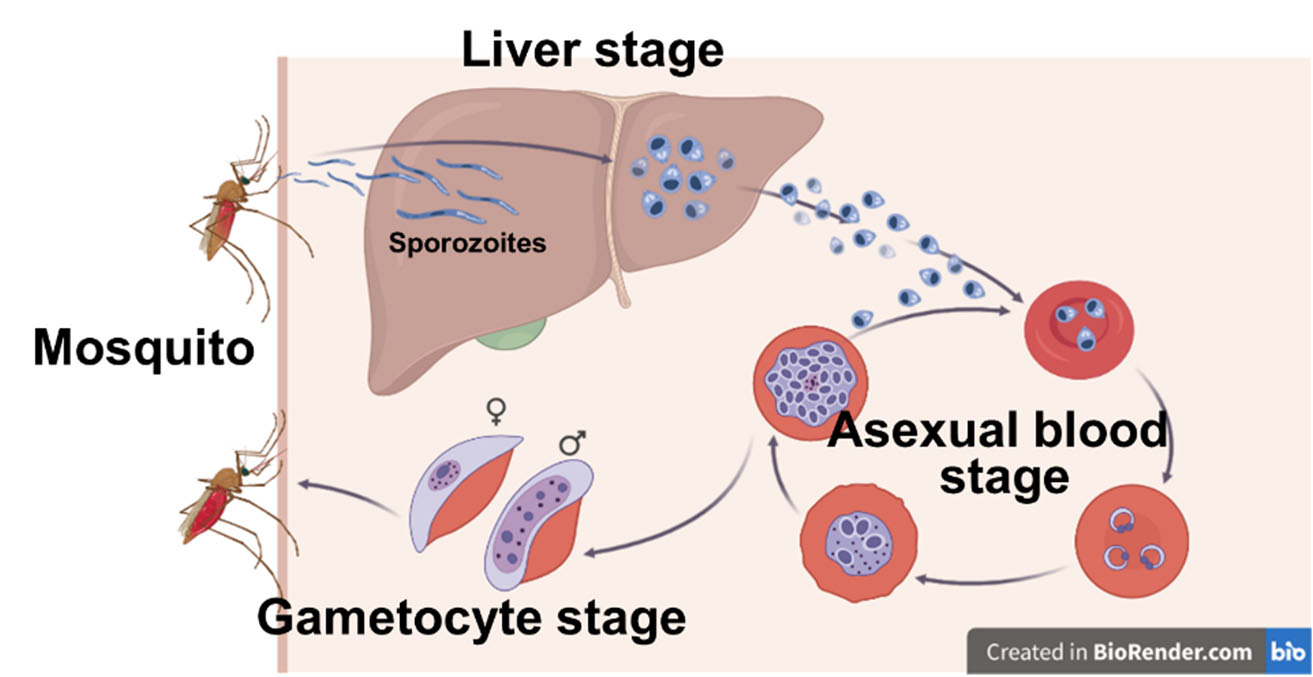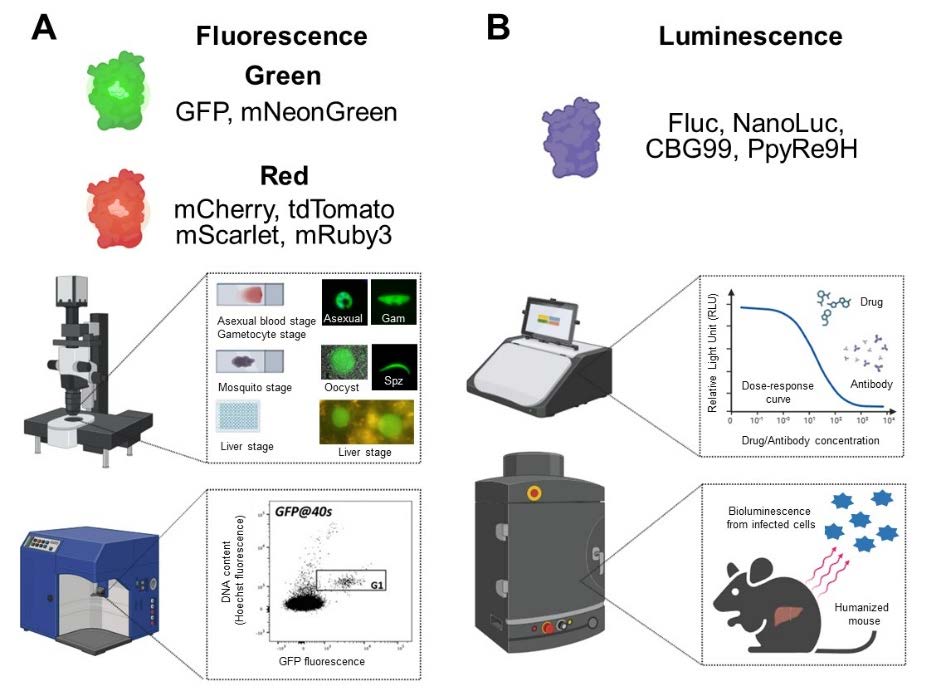

Review article on transgenic reporter malaria parasites published. -New perspectives on studying human malaria parasites and drug discovery-
【Summary】
●Malaria is one of the three major global infectious diseases, with the World Health Organisation
(WHO) estimating that in 2022 there were 249 million cases and 608 000 deaths in 85 countries
worldwide.
● In the study of malaria, the use of genetically engineered reporter malaria parasites has been
actively pursued. The term ‘genetically modified reporter’ refers to the use of recombinant genes,
such as green fluorescent protein, to facilitate the detection and visualization of Plasmodium
falciparum.
●Given the large number of genetically modified P. falciparum reporter parasites that have been
produced, it is important to have up-to-date knowledge of how each has been applied, and to chart new avenues for future malaria research.
●This review article summarizes the usefulness, characteristics, and properties of the transgenic
reporter P. falciparum parasites generated over the past five years for researchers and students
interested in parasite research. It also outlines the latest research on stages in humans and
mosquito vectors using the transgenic reporter, P. falciparum, with the author’s own insights.
● This review provides new perspectives on malaria research and promotes the development of a new transgenic reporter, P. falciparum, which can serve as a useful tool for basic research worldwide.
【Introduction of this review article】
・The life cycle of P. falciparum
Malaria is a parasitic disease caused by Plasmodium falciparum in the tropic area and causing huge numbers of cases. Of the malaria parasites that cause human disease, the most lethal, P. falciparum is of great concern. This parasite multiplies in human erythrocytes and causes malaria symptoms, such as fever, chills, and anemia (asexual blood stage). On the other hand, some P. falciparum parasites in human erythrocytes differentiate into a sexual stage known as the gametocyte stage, which is transmitted back into the mosquito by blood sucking. Once inside the body of the mosquito, P. falciparum parasites multiply in the midgut of the mosquitoes, where they transform into a stage called sporozoites and migrate to the salivary glands. P. falciparum then infects humans again when the sporozoite-bearing mosquito again sucks blood from humans. Once in the human bloodstream, sporozoites first infect the liver, where they undergo an incubation period before infecting human erythrocytes and causing malaria. Thus, P. falciparum infects two different hosts, humans and mosquitoes, and has a very complex life cycle (Fig. 1).

Figure 1. Schematics of the P. falciparum life cycle
・Application and development of the transgenic reporter, P. falciparum.
A large number of different transgenic reporter P. falciparum have been developed to elucidate the complex life cycle in detail and have been applied to basic research and drug discovery (Fig. 2). The transgenic reporter P. falciparum expresses various reporter proteins such as fluorescent proteins and luciferases.Signals from expressed reporter proteins can be analyzed using specific analytical instruments for a variety of applications. Specifically, in the case of fluorescent proteins, fluorescence microscopy can be used to detect and visualize the stages in human and mosquito hosts. In the case of luciferases, the number of parasites can be quantified with high sensitivity and accuracy by measuring the bioluminescence signal using a luminometer. Quantification of parasites enables the evaluation of a large number of compounds with antimalarial activity.

Figure 2. Applications of transgenic reporter P. falciparum
The first transgenic reporter line in malaria parasites was generated more than 20 years ago.
After their usefulness was demonstrated, malaria researchers worldwide developed numerous transgenic reporters, P. falciparum, incorporating their own ideas and methods to drive basic and drug discovery research. The transgenic reporter P. falciparum is a very useful tool, so it is crucial that researchers interested in parasitology grasp this research field and develop it with new ideas. However, the wide range of properties of the transgenic reporter P. falciparum, which is being developed, has led to a comprehensive discussion of their essential properties. Therefore, Assistant Professors Yukiko Miyazaki and Shinya Miyazaki came up with that it would be important to summarize the research on transgenic reporter P.falciparum, mainly produced in the past five years, to show new avenues in this research field.
【Future perspectives on this review article】
This review article outlines recent findings on the transgenic reporter P. falciparum expressing
fluorescent proteins and luciferases and provides new perspectives for future basic research and drug discovery in malaria. This review is aimed at researchers and students interested in parasitology. We hope that the content of this review will help advance basic research and drug discovery in malaria research.
【Papers】
Journal︓Trends in Parasitology (Cell Press, 5-year impact factor: 8.1)
Title︓Reporter parasite lines: Valuable tools for the study of Plasmodium biology
Authors︓Yukiko Miyazaki, Shinya Miyazaki*
Affiliation: Department of Protozoology, Institute of Tropical Medicine (NEKKEN), Nagasaki University,
852-8523, Nagasaki, Japan.
Link:Reporter parasite lines: valuable tools for the study of Plasmodium biology – ScienceDirect
*Corresponding author, E-mail: smiyazaki@nagasaki-u.ac.jp
【Glossary】
Review article
An academic article in the form of an overview of the latest findings on a particular research topic. This differs from the original article, which is based on the authors’ own research findings. The review article presented here was written with researchers and students as intended readers.
Malaria
Parasitic infectious disease caused by a protozoan of the genus Plasmodium. Several Plasmodium
species are known to cause malaria in humans, and this review focuses mainly on Plasmodium falciparum, which causes the most severe symptoms in humans. P. falciparum is transmitted from humans to mosquitoes by the blood sucking of vector mosquitoes, multiplies in the mosquito’s body and then infects other humans again by the mosquito’s bite. Therefore, there is a need for a drug that is effective against parasites in humans and mosquitoes.
Fluorescent protein
A protein emitting fluorescence, such as green fluorescent protein (GFP). When a fluorescent protein is exposed to light of a specific wavelength, it emits fluorescence at different wavelengths. The localization and quantity of fluorescent proteins in the cell can be determined by detecting their fluorescence using specific analytical instruments (e.g., fluorescence microscopy and flow cytometry).
Luciferase
A protein that emits light through an enzymatic reaction such as firefly luciferase. When luciferase reacts with a specific luminescent substance, the enzymatic reaction proceeds and light of a specific wavelength is emitted. The amount of emitted light can be detected using specific analytical instruments to determine the amount of luciferase.
【References】(Miyazaki Y: Yukiko Miyazaki, Miyazaki S: Shinya Miyazaki)
1. Miyazaki Y†, Vos MW, Geurten FJA, Bigeard P, Kroeze K, Yoshioka S, Arisawa M, Inaoka DK, Soulard V, Dechering KJ, Franke-Fayard B, Miyazaki S†
A versatile Plasmodium falciparum reporter line expressing NanoLuc enables highly sensitive multi-stage drug assays.
Communications Biology. 2023 Jul. doi: 10.1038/s42003-023-05078-5 (†Corresponding author)
Link: A versatile Plasmodium falciparum reporter line expressing NanoLuc enables highly sensitive multi-stage drug assays | Communications Biology (nature.com)
Press release︓A genetically engineered Plasmodium falciparum expressing NanoLuc as an innovative tool for malaria drug discovery (nagasaki-u.ac.jp)
2. Miyazaki S†, Yang ASP, Geurten FJA, Marin-Mogollon C, Miyazaki Y, Imai T, Kolli SK, Ramesar J, Chevalley-Maurel S, van Gemert GJ, van Waardenburg YM, Franke-Fayard B, Hill AVS, Sauerwein RW, Janse CJ†, Khan SM
Generation of novel Plasmodium falciparum NF135 and NF54 lines expressing fluorescent reporter proteins under the control of strong and constitutive promoters.
Front Cell Infect Microbiol. 2020 Jun 10;10:270. doi: 10.3389/fcimb.2020.00270. (†corresponding author)
Link: Frontiers | Generation of Novel Plasmodium falciparum NF135 and NF54 Lines Expressing Fluorescent Reporter Proteins Under the Control of Strong and Constitutive Promoters (frontiersin.org)
3. Marin-Mogollon C, Salman AM, Koolen KMJ, Bolscher JM, van Pul FJA, Miyazaki S, Imai T, Othman AS, Ramesar J,van Gemert GJ, Kroeze H, Chevalley-Maurel S, Franke-Fayard B, Sauerwein RW, Hill AVS, Dechering KJ, Janse CJ,Khan SM
A P. falciparum NF54 Reporter Line Expressing mCherry-Luciferase in Gametocytes, Sporozoites, and Liver-Stages.
Front Cell Infect Microbiol. 2019 Apr 16;9:96. doi: 10.3389/fcimb.2019.00096. eCollection 2019.
Link: Frontiers | A P. falciparum NF54 Reporter Line Expressing mCherry-Luciferase in Gametocytes, Sporozoites, and Liver-Stages (frontiersin.org)
【Acknowledgement】
We would like to take this opportunity to express our deepest gratitude to all those involved in writing this review. Publication of this review was supported by a Grant-in-Aid for Scientific Research (C): 24K10191,represented by Shinya Miyazaki.